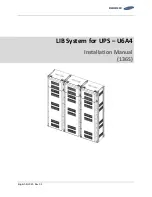
10
8K~12KVA
Rear panel
(With ISO)
11
5.3 Connection to mains and loads (5000 - 12000 VA)
Only qualified specialists or technicians who conform to applicable safety standards may
carry out the installation of this equipment. The installation must further comply with all
local legislation and regulations.
Follow all installation and safety instructions very carefully, otherwise those performing
installation may suffer from a hazardous situation and the UPS or load connections may
also be damaged.
The high voltage and current contained within the UPS equipment can injure or
kill personnel and damage equipment.
For electrical installation, closely observe the nominal current rating of the source.
Installing External battery cabinets
First disconnect the UPS from mains and loads before attempting an External Battery
Cabinet installation.
Use the battery cable provided with the External Battery Cabinet to connect the External
Battery Cabinet to the UPS. Connect a second battery cabinet to the first one with the
cable provided if more than one is to be installed.
Be aware of UPS parameters and changing the Battery pack quantity when using the
external battery cabinets (see chapter 7.2)
Installing UPS
Ensure that the installation site has all electrical connections properly carried out. In
addition, refer to figures 2 and 3 to check the fuse and cable dimensions.
Isolate and secure the source against reclosing. Both input and output circuit breakers
(located in the back) must be “OFF”.
Refer to figure 2 for single cable input and figure 3 for dual cable input. Connect the
UPS according to these diagrams. If installing dual cables, the interconnection jumper
(b*) needs to be removed as in figure 2. Fuse and cable sizes are given in figure 3.
During installation, if it cannot be determined that neutral is grounded or the
identification of the neutral status of the mains supply is unreliable, an additional two
pole disconnect device is necessary in the building installation.
At the back of the unit you will find the Emergency Power Off (EPO), which when
open will immediately shut down the logic circuit output of the UPS as in figure 2 and 3.
Wiring the EPO signal is optional.
Caution!
Local safety requirements may require a separate external Emergency Power
Off that opens output circuit breakers, and if so, use figures 2 and 3 for proper
installation. Refer to local wiring rules.
Should computer or alarm connections be used, use connections according to chapter 6
of the manual provided with that option. The connections can be referred to on the rear
panel.
The installation is now complete.
b*) removable jumper when dual input used



































